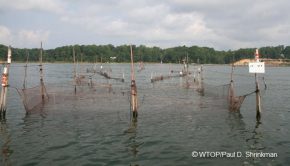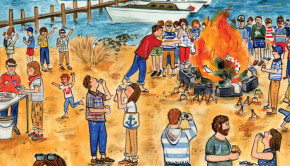Chesapeake Bay is a fickle mistress
Published on February 7th, 2022
Located in the Mid-Atlantic region, the Chesapeake Bay extends approximately 174nm from its northern headwaters in the Susquehanna River to its outlet in the Atlantic Ocean. It is the largest estuary in the United States with plenty of places to go.
George Burke of Fishing Bay Yacht Club shares one such outing many years ago on Chesapeake Bay:
When it comes to wind velocity, the Chesapeake Bay is a fickle mistress. Her capacity to dial up every scale of weather short of a gale in the course of a routine afternoon is legendary.
She does this in collusion with her numerous tributaries, all of which provide their own claims on how the currents and winds should behave, and with her hidden ancient partner, the deep ghost of the Sesquehanna, lacing down the center of the shoal-draft Chesapeake waters and providing her own reservoir of nasty surprises.
Thus it was that I and three neophytes set off on a 25nm cruise from Deltaville, VA at the Rapahannock’s mouth to Tangier Island on an August afternoon in 1990. As the proud but naive new owner of a 16 year old Sabre 28, aptly named Traumerei (a sonata by Schuman recalling childhood dreams), I was the skipper.
My brothers Michael (trimmer) and Dean (captain of sea sickness) crewed, along with family friend George Kennedy (our resident optimist). Under full main, 155% genoa, and bright sunshine, Traumerei set off close reaching in 8 knots of wind and flat seas……Perfect!
The first volatile gust occurred one hour into her journey, heading and healing us sharply while the crew was luxuriating on the cabin trunk sipping their third coffee. No worries. Coffee cleans up easily once a wave or two comes aboard.
My wet footed, stained deckhands crawled toward the cockpit and resumed their placid lack of awareness. Then one of them pointed forward and asked what that commotion was on the horizon. “More wind. Lots of wind!” I said, now realizing that the big genoa was going to be overkill, or perhaps “turn over and kill”.
Traumerei carried bronze, hanked foresails of a certain age, with snaps that hid their corrosion well. Changing sails required suspending one’s concept of time. Having no confidence that any of my crew could work the foredeck and stay aboard in these conditions, I crept forward and accepted my prolonged dousing while they took turns steering erratically into the increasing wind.
The foredeck pitched and rolled like a bull ride, but eventually a 125 percent genoa and flattening reef on the main seemed to serve. Soaked to the bone, I heard one of the crew declare how much fun they were having. But Traumerei charged forward, parting the chop with authority…..Perfect again!
It wasn’t until our angle of heel reached 30 degrees that I realized how alarmed my companions had become. “Let’s not get upset over a little bit of tilting,” I screamed over the wind, trying to control my churning stomach.
After a repeat foredeck drill, including an encore of gushing seawater, Traumerei shed her 125 and donned a working jib and reefed main. But the wind stayed a step ahead all afternoon. Traumerei remained radically heeled, pitching and pounding, and clearly losing her sense of authority, as was I.
Now we were 20 degrees off course, missing the Tangier light by three miles and heading straight into the Watts Island flats. If we were going to fetch Tangier Sound on our next tack, we needed to sail as deeply into the flats as heel, keel, and imprudent zeal would allow.
“Let’s do it,” said the resident optimist.
These were the days before GPS navigation, when line of sight and dead reckoning ruled. Watts Island was devoid of aids to navigation or landmarks. Our depth finder, incapacitated by the radical heeling and heavy chop, had long since surrendered.
Straining and squinting into the mist and spray, we watched a wall of Watts Island pines grow rapidly, trying to gauge the exact time we must tack. That moment came when we were a biscuit toss from the nearest tree.
“Now!” I yelled. Traumerei came about smartly without grounding, while we held our breath, and our captain of sea sickness tossed his lunch leeward.
By the time we reached Tangier harbor, Traumerei was down to a storm jib and handkerchief. The wind had just dropped to 5 knots in the Sound. Wet, shaken, and grateful, we stepped ashore, now one word wiser to the wiles of the Chesapeake.
“Yune boys shorn picta nice sonny day to vis’t,” a smiling islander greeted us in his unique native accent.







 We’ll keep your information safe.
We’ll keep your information safe.